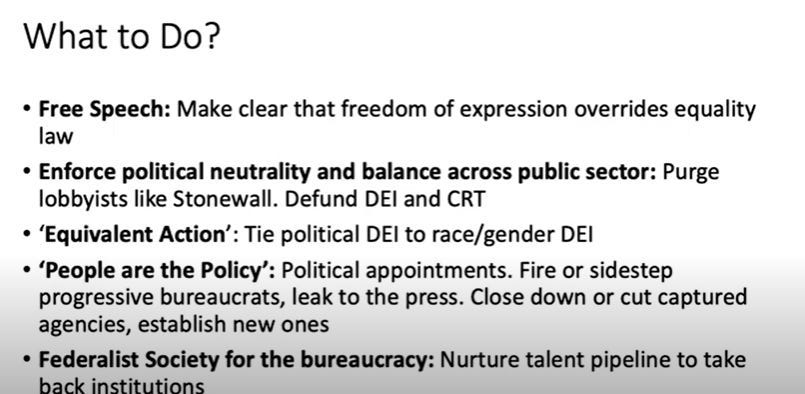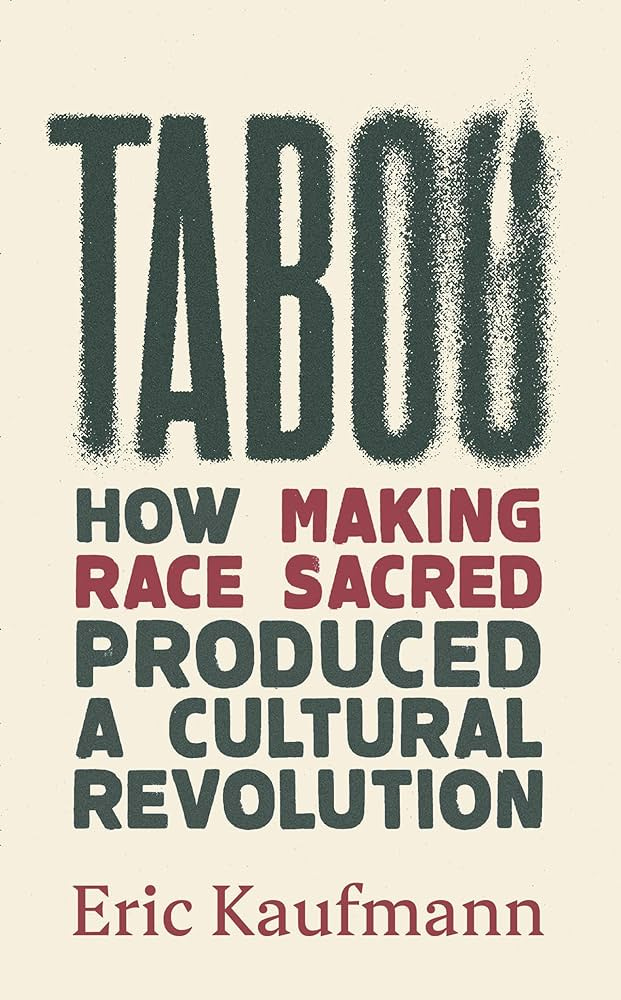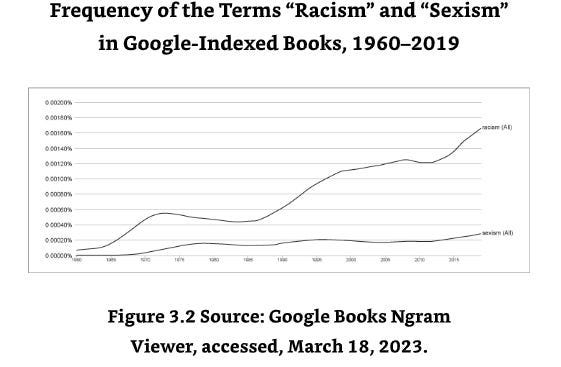Book Review: 'Taboo/The Third Awokening' by Eric Kaufmann
Kaufmann provides some useful insights, but after analysing the chilling leviathan of minority-rights fundamentalism, gives too many concessions to it. (Originally published July 2024)
NOTE: This article was originally published in July 2024. It has been re-edited to make it read better.
Eric Kaufmann is an amazing guy, who I actually had the privilege of meeting at the 2023 Battle of Ideas conference. Virtually everybody who’s met the man has only had good things to say about him.
After meeting him, and previously knowing him from his short-form essays and news reports, I bought and read his book ‘Whiteshift’, which was a major influence on me to think more seriously about demographics, before having been an ‘anti-Woke first’ type person.
His style of writing was palatable enough for me, as somebody who wasn’t completely on the ethno-nationalist side but interested in the arguments, that it served as the perfect stepping stone for me to access more bold critiques of mass replacement immigration.
‘Taboo’ (I will use the British name for the release from this point on) is aimed at a similar audience to ‘Whiteshift’, aka people who are not entirely in our sphere but are able to consider the ideas when communicated in a specific way. Kaufmann has a very dispassionate look at various issues that makes the blood boil of people like me (Gen Z Wokeness), but yet this is why he is the ideal communicator.
In this review, I will explain Kaufmann’s core thesis and how it differs from the Postliberal perspective, Richard Hanania/Christopher Caldwell ‘legal Wokeness’ (1) perspective and the Christopher F. Rufo (2) and James Lindsay ‘organised cultural takeover’ perspective.
I will then also discuss some of the points he emphasises in his quantitative data analysis; and then summarise his solutions. Like in my review of Hanania’s ‘The Origins of Woke’ I will then talk about the points where I agreed and where I disagreed. My conclusion will be that I think this book is a valuable contribution to the discourse, though it is aimed at people a little bit less down the pipeline than people who read Anglofuturist Magazine are, and sometimes falls into Boomer Truth-narrative traps.
Kaufmann’s Explanation of Wokeness
Kaufmann presents his narrative as significantly different from the three main schools of thought in explaining the Origins of Wokeness.
1) the ‘organised cultural takeover’ narrative, put forward by people like James Lindsay and Chris Rufo, of a ‘Long March Through the Institutions’ by ‘Cultural Marxists’,
2) the ‘legal evolution’ narrative put forward by Christopher Caldwell and Richard Hanania, which traces Wokeness back to needing to comply with Civil Rights law, either the parts of the 1964 act itself (Caldwell, Title II and VII) or later amendments and court rulings expanding the act (Hanania).
3) the Postliberal/National Conservative narrative by Patrick Deneen and Yoram Hazony respectively, who trace Wokeness back to a Social Contract theory of liberalism.
Kaufmann’s view of Wokeness (which he refers to as ‘cultural socialism’ of equal outcomes between non-economic identity groups, a parallel to economic socialism’s equal outcomes between economic groups) is that it emerged bottom up as an ‘instinct’ of ‘Minorities Good, Majorities Bad’.
He uses Jonathan Haidt’s Moral Foundations Theory throughout the book to analyse it as a cultural diffusion where care/harm became the overwhelmingly predominant moral foundation.
This started with race, beginning in the 1950s and accelerating in the 1960s with the Civil Rights Movement. He provides a quote from a newspaper article from Susan Sontag which sounds eerily contemporary, to demonstrate that on the elite level, minoritarian instincts were well established in America by the 1960s. He rightly points out that all of the other Woke movements, like feminism and LGBT, were later added to the initial taboo about race, due to weaponizing the language of the Civil Rights Movement and hoping to harness what he calls the ‘identitarian magic’.
Kaufmann also points out that Wokeness emerged predominantly through the anti-communist liberal left, not the Marxist left, which distinguishes his theory from that of Chris Rufo, who focuses on a small band of (Neo-)Marxist radicals. For Kaufmann, one can be a ‘cultural socialist’ without being an economic socialist, and indeed for many of these left-liberals their cultural socialism was to compensate for their lack of economic socialism. However, whilst communism’s horrors made economic socialism discredited, there was no such immunity in Western culture for cultural socialism, so its influence grew.
He talks about the ‘holy trinity’ of race, sex, and gender, where all Woke ‘cultural socialism’ bases itself on a core metric of those. There are other attributes like intelligence and beauty that are not (yet) part of Woke, but it’s only race and sex/gender (LGBT representation isn’t yet as dominant) where equal group outcomes are demanded across society. Therefore, the Woke ‘cultural socialism’ is based around the ‘holy trinity’.
To counter Hanania and Caldwell’s theories of ‘Wokeism as law’, Kaufmann recounts the time when Reagan tried to soften diversity quotas and affirmative action, but corporations themselves started a campaign for them to be reinstated. Failing this, most continued with them even though they were no longer (for a short while) required to do so.
This shows that elites genuinely believed in the ideals of Wokeness, and a bit like how a moderate Muslim fails to meaningfully respond to an Islamist due to them believing in the same book, for the moderate liberal, it is difficult to resist a Woke drift because they share the same fundamental values, and are mortified by the fact they might not be living up to their own principles, which are based on the care/harm moral foundation.
Kaufmann dismisses the idea that there is still a ‘silent majority’ of people who are with us, and emphasises how hard it will be to fundamentally re-orient this care/harm moral foundation and the ‘Minorities Good, Majorities Bad’ paradigm.
I think when he says this, it is aimed at the small group of Gen Xer IDW-types who still believe, despite everything, that the pendulum will just naturally swing (people convinced by Helen Pluckrose, Andrew Doyle, and other charlatans gatekeepers).
It’s depressing to re-read it, Hanania’s analysis of just repealing a few laws sounds nicer than reversing a cultural takeover that seems to have unstoppable momentum, with deep roots in the Western psyche. But some people unfortunately still need to be reminded of the dire situation we are in.
Kaufmann’s Data Analysis
Kaufmann’s specialism is political science and survey data, and he uses quantitative means to back up his points. Sources he mentions include newspapers and Google searches of certain keywords, like ‘racism’. He essentially echoes my point about the Reagan Era in the US being ‘three steps forward, one step back’ for the cultural left, describing it as a ‘levelling-off effect’, and which risks happening again if we are overly complacent and prematurely declare Woke as ‘on the way out’.
This data is not aimed at the already converted, but people who think that ‘the backlash is finally here’. He provides depressing evidence for his commonly repeated claims of ‘Gen Z are Woke’, and ‘Wokeness is going mainstream’.
Kaufmann’s Solutions

Despite presenting some gut-wrenching data, Kaufmann is not a black-piller because he provides detailed solutions.
Not all of them land, but I highly respect him for providing a positive call to arms at the end and at least ‘trying’ to think of solutions.
This is the perfect balance, the understanding of how damning the situation is, and also what we can do about it. This list of solutions was also on his YouTube lecture, and I have been hugely inspired by many of them, which I will discuss when I list the strengths of the book.
The solutions are:
Legal free speech, including preventing the firing of people for their political views.
Neutral Institutions, with issues that have less than 40% of the public agreeing, or where there is a partisan divide, not uncritically endorsed.
Equivalent action to protect ‘viewpoint discrimination’ compared to racial discrimination.
Open public bodies up to political appointments.
A Federalist Society for the bureaucracy
NRA for the culture war.
Christian Coalition for Secular Culture, he proposes that the secular anti-Woke movement needs to be as organised and as united as the Christian Right.
Austrian School for Culture
Contextualisation of Past and Present - Schools need to teach that there are crimes against humanity on the far-left as well as the far-right.
Retain and Explain - Would give context to statues that are ‘problematic’.
Vivid Political Communications - Effective meme-like talking points.
From Taboos to Jurisprudence: ‘graduated penalties’ based on frequency and severity of the offence.
Before I do a deeper analysis, I will say that I love the ideas of 4, 5, 6, and 11. The others have some good points but fall short on a variety of grounds, of which I will explain.
Strengths of the Book
This book has a great amount of strengths.
Keep reading with a 7-day free trial
Subscribe to The Anglofuturist to keep reading this post and get 7 days of free access to the full post archives.






